Spatiotemporal Variation Characteristics and Driving Mechanisms of Net Primary Productivity of Vegetation on Northern Slope of Tianshan Mountains Based on CASA Model, China
Abstract
1. Introduction
2. Results
2.1. Temporal and Spatial Variations in NPP
2.2. Impacts of Land Use Change and Climate Change on NPP
2.2.1. Impacts of Land Use Change on NPP
2.2.2. Changes in NPP Due to Land Use Changes
2.2.3. Impacts of Climate Change on NPP
2.3. Analysis of NPP Driving Factors
2.3.1. Identification of OPGD Model Parameters
2.3.2. Single Factor Analysis of Influencing Factors
2.3.3. Interaction Detection of Influencing Factors
2.4. CASA Model Validation
3. Discussion
3.1. Advantages of the OPGD Model
3.2. Response of Vegetation NPP to Human Activities
3.3. Response of Vegetation NPP to Climate Change
3.4. Effects of Topographic Factors on Vegetation NPP
3.5. Limitations and Prospects
4. Materials and Methods
4.1. Overview of the Study Area
4.2. Data Sources and Processing
4.3. Research Methodology
4.3.1. Calculation of NPP Using the CASA Model
4.3.2. Trend Analysis and Mann–Kendall Trend Test
4.3.3. Center of Gravity Migration Trajectory Model
4.3.4. Partial Correlation Analysis
4.3.5. OPGD Model
5. Conclusions
Supplementary Materials
Author Contributions
Funding
Data Availability Statement
Acknowledgments
Conflicts of Interest
References
- Cao, M.; Woodward, F.I. Dynamic responses of terrestrial ecosystem carbon cycling to global climate change. Nature 1998, 393, 249–252. [Google Scholar] [CrossRef]
- Pan, Y.; Birdsey, R.A.; Fang, J.; Houghton, R.; Kauppi, P.E.; Kurz, W.A.; Phillips, O.L.; Shvidenko, A.; Lewis, S.L.; Canadell, J.G. A large and persistent carbon sink in the world’s forests. Science 2011, 333, 988–993. [Google Scholar] [CrossRef] [PubMed]
- Jiao, K.; Liu, Z.; Wang, W.; Yu, K.; Mcgrath, M.J.; Xu, W. Carbon cycle responses to climate change across China’s terrestrial ecosystem: Sensitivity and driving process. Sci. Total Environ. 2024, 915, 170053. [Google Scholar] [CrossRef] [PubMed]
- Zhang, Y.; Zhang, C.; Wang, Z.; Chen, Y.; Gang, C.; An, R.; Li, J. Vegetation dynamics and its driving forces from climate change and human activities in the Three-River Source Region, China from 1982 to 2012. Sci. Total Environ. 2016, 563, 210–220. [Google Scholar] [CrossRef] [PubMed]
- Liu, Y.; Yang, Y.; Wang, Q.; Du, X.; Li, J.; Gang, C.; Zhou, W.; Wang, Z. Evaluating the responses of net primary productivity and carbon use efficiency of global grassland to climate variability along an aridity gradient. Sci. Total Environ. 2019, 625, 671–682. [Google Scholar] [CrossRef]
- Yue, D.; Zhou, Y.; Guo, J.; Chao, Z.; Liang, G.; Zheng, X. Ecosystem service evaluation and optimisation in the Shule River Basin, China. Catena 2022, 215, 106320. [Google Scholar] [CrossRef]
- Ma, Z.; Wu, J.; Yang, H.; Hong, Z.; Yang, J.; Gao, L. Assessment of vegetation net primary productivity variation and influencing factors in the Beijing-Tianjin-Hebei region. J. Environ. Manag. 2024, 365, 121490. [Google Scholar] [CrossRef]
- Ruimy, A.; Saugier, B.; Dedieu, G. Methodology for the estimation of terrestrial net primary production from remotely sensed data. J. Geophys. Res. Atmos. 1994, 99, 5263–5283. [Google Scholar] [CrossRef]
- Xu, Y.; Xiao, F.; Yu, L. Review of spatio-temporal distribution of net primary productity in forest ecosystem and its responses to climate change in China. Acta Ecol. Sin. 2020, 40, 4710–4723. [Google Scholar]
- Hou, G.; Wu, S.; Long, W.; Chen, C.; Zhang, Z.; Fang, Y.; Zhang, Y.; Luo, G. Quantitative analysis of the impact of climate change and oasification on changes in net primary productivity variation in mid-Tianshan Mountains from 2001 to 2020. Ecol. Indic. 2023, 154, 110820. [Google Scholar] [CrossRef]
- Luo, G.; Feng, Y.; Zhang, B.; Cheng, W. Sustainable land-use patterns for arid lands: A case study in the northern slope areas of the Tianshan Mountains. J. Geogr. Sci. 2010, 20, 510–524. [Google Scholar] [CrossRef]
- Zhang, Q.; Luo, G.; Li, L.; Zhang, M.; Lv, N.; Wang, X. An analysis of oasis evolution based on land use and land cover change: A case study in the Sangong River Basin on the northern slope of the Tianshan Mountains. J. Geogr. Sci. 2017, 27, 223–239. [Google Scholar] [CrossRef]
- Li, L.; Wang, S.; Chen, Y.; Zhang, H.; Zhang, J.; Xu, Y.; Wei, J. Climate change in the Eastern Xinjiang of China and its connection to northwestern warm humidification. Atmosphere 2023, 14, 1421. [Google Scholar] [CrossRef]
- Hu, Z.; Zhang, C.; Hu, Q.; Tian, H. Temperature changes in Central Asia from 1979 to 2011 based on multiple datasets. J. Clim. 2014, 27, 1143–1167. [Google Scholar] [CrossRef]
- Chen, Y.; Li, Z.; Fang, G.; Deng, H. Impact of climate change on water resources in the Tianshan Mountians, Central Asia. Acta Geogr. Sin. 2017, 72, 18–26. [Google Scholar]
- Zou, J.; Ding, J.; Welp, M.; Huang, S.; Liu, B. Assessing the response of ecosystem water use efficiency to drought during and after drought events across Central Asia. Sensors 2020, 20, 581. [Google Scholar] [CrossRef] [PubMed]
- Gower, S.T.; Kucharik, C.J.; Norman, J.M. Direct and indirect estimation of leaf area index, fAPAR, and net primary production of terrestrial ecosystems. Remote Sens. Environ. 1999, 70, 29–51. [Google Scholar] [CrossRef]
- Scurlock, J.; Cramer, W.; Olson, R.; Parton, W.; Prince, S. Terrestrial NPP: Toward a consistent data set forglobal model evaluation. Ecol. Appl. 1999, 9, 913–919. [Google Scholar] [CrossRef]
- Luo, T.; Pan, Y.; Ouyang, H.; Shi, P.; Luo, J.; Yu, Z.; Lu, Q. Leaf area index and net primary productivity along subtropical to alpine gradients in the Tibetan Plateau. Glob. Ecol. Biogeogr. 2004, 13, 345–358. [Google Scholar] [CrossRef]
- He, X.; Zhang, F.; Zhou, T.; Xu, Y.; Xu, Y.; Jim, C.Y.; Johnson, B.A.; Ma, X. Human activities dominated terrestrial productivity increase over the past 22 years in typical arid and semiarid regions of Xinjiang, China. Catena 2025, 250, 108754. [Google Scholar] [CrossRef]
- Li, C.; Sun, H.; Wu, X.; Han, H. Dataset of the net primary production on the Qinghai-Tibetan Plateau using a soil water content improved Biome-BGC model. Data Brief 2019, 27, 104740. [Google Scholar] [CrossRef]
- Pan, Y.; McGuire, A.D.; Kicklighter, D.W.; Melillo, J.M. The importance of climate and soils for estimates of net primary production: A sensitivity analysis with the terrestrial ecosystem model. Glob. Change Biol. 1996, 2, 5–23. [Google Scholar] [CrossRef]
- Wang, P.; Xie, D.; Zhou, Y.; E, Y.; Zhu, Q. Estimation of net primary productivity using a process-based model in Gansu Province, Northwest China. Environ. Earth Sci. 2014, 71, 647–658. [Google Scholar] [CrossRef]
- Zaks, D.P.; Ramankutty, N.; Barford, C.C.; Foley, J.A. From Miami to Madison: Investigating the relationship between climate and terrestrial net primary production. Glob. Biogeochem. Cycles 2007, 21, GB3004. [Google Scholar] [CrossRef]
- Pranuthi, G.; Dubey, S.K.; Tripathi, S. Comparison of different models for estimation of net primary productivity in India. J. Agrometeorol. 2012, 14, 105–110. [Google Scholar] [CrossRef]
- Yu, R. An improved estimation of net primary productivity of grassland in the Qinghai-Tibet region using light use efficiency with vegetation photosynthesis model. Ecol. Model. 2020, 431, 109121. [Google Scholar] [CrossRef]
- Sannigrahi, S. Modeling terrestrial ecosystem productivity of an estuarine ecosystem in the Sundarban Biosphere Region, India using seven ecosystem models. Ecol. Model. 2017, 356, 73–90. [Google Scholar] [CrossRef]
- Zhu, P.; Liu, G.; He, J. Spatio-temporal variation and impacting factors of NPP from 2001 to 2020 in Sanjiangyuan region, China: A deep neural network-based quantitative estimation approach. Ecol. Inform. 2023, 78, 102345. [Google Scholar] [CrossRef]
- He, C.; Liu, Z.; Xu, M.; Ma, Q.; Dou, Y. Urban expansion brought stress to food security in China: Evidence from decreased cropland net primary productivity. Sci. Total Environ. 2017, 576, 660–670. [Google Scholar] [CrossRef]
- Zhang, J.; Wang, J.; Chen, Y.; Huang, S.; Liang, B. Spatiotemporal variation and prediction of NPP in Beijing-Tianjin-Hebei region by coupling PLUS and CASA models. Ecol. Inform. 2024, 81, 102620. [Google Scholar] [CrossRef]
- Potter, C.; Klooster, S.; Genovese, V.; Hiatt, C. Forest production predicted from satellite image analysis for the Southeast Asia region. Carbon Balance Manag. 2013, 8, 9. [Google Scholar] [CrossRef]
- Jay, S.; Potter, C.; Crabtree, R.; Genovese, V.; Weiss, D.J.; Kraft, M. Evaluation of modelled net primary production using MODIS and landsat satellite data fusion. Carbon Balance Manag. 2016, 11, 8. [Google Scholar] [CrossRef]
- Zhu, W.; Pan, Y.; Zhang, J. Estimation of net primary productivity of chinese terrestrial vegetation based on remote sensing. Chin. J. Plant Ecol. 2007, 31, 413–424. [Google Scholar]
- Chen, J.; Shao, Z.; Huang, X.; Hu, B. Multi-source data-driven estimation of urban net primary productivity: A case study of Wuhan. Int. J. Appl. Earth Obs. Geoinf. 2024, 127, 103638. [Google Scholar] [CrossRef]
- Mao, R.; Xing, L.; Wu, Q.; Song, J.; Li, Q.; Long, Y.; Shi, Y.; Huang, P.; Zhang, Q. Evaluating net primary productivity dynamics and their response to land-use change in the loess plateau after the’Grain for Green’program. J. Environ. Manag. 2024, 360, 121112. [Google Scholar] [CrossRef]
- Lu, Z.; Chen, P.; Yang, Y.; Zhang, S.; Zhang, C.; Zhu, H. Exploring quantification and analyzing driving force for spatial and temporal differentiation characteristics of vegetation net primary productivity in Shandong Province, China. Ecol. Indic. 2023, 153, 110471. [Google Scholar] [CrossRef]
- Tobias, J.A.; Durant, S.M.; Pettorelli, N. Improving predictions of climate change–land use change interactions. Trends Ecol. Evol. 2021, 36, 29–38. [Google Scholar] [CrossRef]
- Chowdhuri, I.; Pal, S.C. Hydrochemical properties of groundwater and land use and land cover changes impact on agricultural productivity: An empirical observation and integrated framework approaches. J. Geochem. Explor. 2024, 258, 107402. [Google Scholar] [CrossRef]
- Roy, P.; Pal, S.C.; Chakrabortty, R.; Chowdhuri, I.; Malik, S.; Das, B. Threats of climate and land use change on future flood susceptibility. J. Clean. Prod. 2020, 272, 122757. [Google Scholar] [CrossRef]
- Pal, S.C.; Chowdhuri, I.; Das, B.; Chakrabortty, R.; Roy, P.; Saha, A.; Shit, M. Threats of climate change and land use patterns enhance the susceptibility of future floods in India. J. Environ. Manag. 2022, 305, 114317. [Google Scholar] [CrossRef] [PubMed]
- Hua, Y.; Wei, Y.; Chen, L. The influences of climate factors on net primary productivity of Gannan grassland, the Qinghai-Tibet Plateau, China. Theor. Appl. Climatol. 2025, 156, 34. [Google Scholar] [CrossRef]
- Xiong, Q.; Xiao, Y.; Halmy, M.W.A.; Dakhil, M.A.; Liang, P.; Liu, C.; Zhang, L.; Pandey, B.; Pan, K.; El Kafraway, S.B. Monitoring the impact of climate change and human activities on grassland vegetation dynamics in the northeastern Qinghai-Tibet Plateau of China during 2000–2015. J. Arid Land 2019, 11, 637–651. [Google Scholar] [CrossRef]
- Tao, J.; Xie, Y.; Wang, W.; Zhu, J.; Zhang, Y.; Zhang, X. Elevational Gradient of Climate-Driving Effects on Cropland Ecosystem Net Primary Productivity in Alpine Region of the Southwest China. Remote Sens. 2022, 14, 3069. [Google Scholar] [CrossRef]
- Cai, Y.; Liu, X.; Liu, K.; Zeng, L.; Pei, F.; Zhuang, H.; Wen, Y.; Wu, C.; Li, B. Human activities significantly impact China’s net primary production variation from 2001 to 2020. Prog. Phys. Geogr. Earth Environ. 2024, 48, 251–274. [Google Scholar] [CrossRef]
- Liang, S.; Peng, S.; Chen, Y. Carbon cycles of forest ecosystems in a typical climate transition zone under future climate change: A case study of Shaanxi Province, China. Forests 2019, 10, 1150. [Google Scholar] [CrossRef]
- Xu, Q.; Li, J.; Zhang, S.; Yuan, Q.; Ren, P. Spatio-Temporal Changes and Driving Mechanisms of Vegetation Net Primary Productivity in Xinjiang, China from 2001 to 2022. Land 2024, 13, 1305. [Google Scholar] [CrossRef]
- Li, J.; Feng, Q.; Guo, Q. Fractal study of sustainable proportions of natural and artificial oases. Environ. Geol. 2008, 55, 1389–1396. [Google Scholar] [CrossRef]
- Song, K.; Cheng, W.; Wang, B.; Xu, H.; Wang, R.; Zhang, Y. Study on the Expansion Potential of Artificial Oases in Xinjiang by Coupling Geomorphic Features and Hierarchical Clustering. Remote Sens. 2024, 16, 1701. [Google Scholar] [CrossRef]
- Liu, H.; Zhang, M.; Lin, Z.; Xu, X. Spatial heterogeneity of the relationship between vegetation dynamics and climate change and their driving forces at multiple time scales in Southwest China. Agric. For. Meteorol. 2018, 256, 10–21. [Google Scholar] [CrossRef]
- Hao, X.; Wang, X.; Ma, J.; Chen, Y.; Luo, S. Spatiotemporal Characteristic Prediction and Driving Factor Analysis of Vegetation Net Primary Productivity in Central China Covering the Period of 2001–2019. Land 2023, 12, 2121. [Google Scholar] [CrossRef]
- Yin, Y.; Ma, D.; Wu, S.; Dai, E.; Zhu, Z.; Myneni, R.B. Nonlinear variations of forest leaf area index over China during 1982–2010 based on EEMD method. Int. J. Biometeorol. 2017, 61, 977–988. [Google Scholar] [CrossRef]
- Pan, N.; Feng, X.; Fu, B.; Wang, S.; Ji, F.; Pan, S. Increasing global vegetation browning hidden in overall vegetation greening: Insights from time-varying trends. Remote Sens. Environ. 2018, 214, 59–72. [Google Scholar] [CrossRef]
- Song, Y.; Wang, J.; Ge, Y.; Xu, C. An optimal parameters-based geographical detector model enhances geographic characteristics of explanatory variables for spatial heterogeneity analysis: Cases with different types of spatial data. GIScience Remote Sens. 2020, 57, 593–610. [Google Scholar] [CrossRef]
- Zhang, W.; Xi, M.; Liu, H.; Zheng, H. Low sensitivity of net primary productivity to climatic factors in three karst provinces in southwest China from 1981 to 2019. Ecol. Indic. 2023, 153, 110465. [Google Scholar] [CrossRef]
- Shi, S.; Zhu, L.; Luo, Z.; Qiu, H. Quantitative analysis of the contributions of climatic and anthropogenic factors to the variation in net primary productivity, China. Remote Sens. 2023, 15, 789. [Google Scholar] [CrossRef]
- Du, Y.; Li, X.; He, X.; Li, X.; Yang, G.; Li, D.; Xu, W.; Qiao, X.; Li, C.; Sui, L. Multi-scenario simulation and trade-off analysis of ecological service value in the Manas River Basin based on land use optimization in China. Int. J. Environ. Res. Public Health 2022, 19, 6216. [Google Scholar] [CrossRef] [PubMed]
- Dang, C.; Shao, Z.; Huang, X.; Zhuang, Q.; Cheng, G.; Qian, J. Climate warming-induced phenology changes dominate vegetation productivity in Northern Hemisphere ecosystems. Ecol. Indic. 2023, 151, 110326. [Google Scholar] [CrossRef]
- Zhao, M.; Running, S.W. Drought-induced reduction in global terrestrial net primary production from 2000 through 2009. Science 2010, 329, 940–943. [Google Scholar] [CrossRef]
- Jiang, X.; Shen, W.; Bai, X. Response of net primary productivity to vegetation restoration in Chinese Loess Plateau during 1986–2015. PLoS ONE 2019, 14, e0219270. [Google Scholar] [CrossRef]
- Yisilayili, G.; He, B.; Song, Y.; Luo, X.; Yang, W.; Chen, Y. Simulation of Vegetation NPP in Typical Arid Regions Based on the CASA Model and Quantification of Its Driving Factors. Land 2025, 14, 371. [Google Scholar] [CrossRef]
- Luo, J.; Halike, A.; Duan, Y.; Yao, K.; Yao, L.; Tang, H.; Tuheti, B. Spatiotemporal dynamics and driving factors of net primary productivity in the Ebinur Lake Basin. Acta Ecol. Sin. 2025, 45, 182–196. [Google Scholar] [CrossRef]
- He, Y.; Ma, S.; Zhang, L.; Zhang, Y.; He, L. Spatio-temporal change of net primary productivity and the evaluatation of the importance of biodiversity maintenance functions in Manas River Basin. Acta Ecol. Sin. 2023, 43, 4664–4673. [Google Scholar] [CrossRef]
- Jiao, W.; Chen, Y.; Li, Z. Remote sensing estimation and the reasons for temporal-spatial differences of vegetation net primary productivity in arid region of Northwest China. Chin. J. Ecol. 2017, 36, 181–189. [Google Scholar] [CrossRef]
- Li, W.; Zhou, J.; Xu, Z.; Liang, Y.; Shi, J.; Zhao, X. Climate impact greater on vegetation NPP but human enhance benefits after the Grain for Green Program in Loess Plateau. Ecol. Indic. 2023, 157, 111201. [Google Scholar] [CrossRef]
- Ge, W.; Deng, L.; Wang, F.; Han, J. Quantifying the contributions of human activities and climate change to vegetation net primary productivity dynamics in China from 2001 to 2016. Sci. Total Environ. 2021, 773, 145648. [Google Scholar] [CrossRef] [PubMed]
- Liao, X.; Fang, C.; Shu, T. Multifaceted land use change and varied responses of ecological carrying capacity: A case study of Chongqing, China. Appl. Geogr. 2022, 148, 102806. [Google Scholar] [CrossRef]
- Jiang, S.; Chen, X.; Smettem, K.; Wang, T. Climate and land use influences on changing spatiotemporal patterns of mountain vegetation cover in southwest China. Ecol. Indic. 2021, 121, 107193. [Google Scholar] [CrossRef]
- Zhai, Y.; Wang, Y.; Hao, L.; Qi, W. Medium-and long-term independent contributions of climate change, management measures and land conversion to vegetation dynamics and inspiration for ecological restoration in Inner Mongolia, China. Ecol. Eng. 2025, 212, 107504. [Google Scholar] [CrossRef]
- Wu, K.; Zhou, C.; Zhang, Y.; Xu, Y. Long-term spatiotemporal variation of net primary productivity and its correlation with the urbanization: A case study in Hubei Province, China. Front. Environ. Sci. 2022, 9, 808401. [Google Scholar] [CrossRef]
- Gao, J.; Liu, M.; Wang, X. Unveiling the Impact of Urbanization on Net Primary Productivity: Insights from the Yangtze River Delta Urban Agglomeration. Land 2024, 13, 562. [Google Scholar] [CrossRef]
- Guang, Y.; Dong, C.; Xinlin, H.; Aihua, L.; Mingjie, Y.; Xiaolong, L. Land use change characteristics affected by water saving practices in Manas River Basin, China using Landsat satellite images. Int. J. Agric. Biol. Eng. 2017, 10, 123–133. [Google Scholar] [CrossRef]
- Ye, C.; Sun, J.; Liu, M.; Xiong, J.; Zong, N.; Hu, J.; Huang, Y.; Duan, X.; Tsunekawa, A. Concurrent and lagged effects of extreme drought induce net reduction in vegetation carbon uptake on Tibetan Plateau. Remote Sens. 2020, 12, 2347. [Google Scholar] [CrossRef]
- Niu, S.; Wu, M.; Han, Y.; Xia, J.; Li, L.; Wan, S. Water-mediated responses of ecosystem carbon fluxes to climatic change in a temperate steppe. New Phytol. 2008, 177, 209–219. [Google Scholar] [CrossRef]
- Wang, J.; Sun, H.; Xiong, J.; He, D.; Cheng, W.; Ye, C.; Yong, Z.; Huang, X. Dynamics and drivers of vegetation phenology in three-river headwaters region based on the Google Earth engine. Remote Sens. 2021, 13, 2528. [Google Scholar] [CrossRef]
- Guo, D.; Song, X.; Hu, R.; Cai, S.; Zhu, X.; Hao, Y. Grassland type-dependent spatiotemporal characteristics of productivity in Inner Mongolia and its response to climate factors. Sci. Total Environ. 2021, 775, 145644. [Google Scholar] [CrossRef]
- Hao, L.; Wang, S.; Cui, X.; Zhai, Y. Spatiotemporal dynamics of vegetation net primary productivity and its response to climate change in inner Mongolia from 2002 to 2019. Sustainability 2021, 13, 13310. [Google Scholar] [CrossRef]
- Luo, M.; Liu, T.; Meng, F.; Duan, Y.; Bao, A.; Xing, W.; Feng, X.; De Maeyer, P.; Frankl, A. Identifying climate change impacts on water resources in Xinjiang, China. Sci. Total Environ. 2019, 676, 613–626. [Google Scholar] [CrossRef] [PubMed]
- Wang, Y.; Gu, X.; Yang, G.; Yao, J.; Liao, N. Impacts of climate change and human activities on water resources in the Ebinur Lake Basin, Northwest China. J. Arid Land 2021, 13, 581–598. [Google Scholar] [CrossRef]
- Chen, Y.; Rusuli, Y.; Wusiman, A. Analysis of spatial and temporal variation in grassland vegetation cover in Xinjiang section ofTianshan Mountains and the driving factors from 2001 to 2020. Chin. J. Plant Ecol. 2024, 48, 561–576. [Google Scholar]
- Walsh, S.J.; Crawford, T.W.; Welsh, W.F.; Crews-Meyer, K.A. A multiscale analysis of LULC and NDVI variation in Nang Rong district, northeast Thailand. Agric. Ecosyst. Environ. 2001, 85, 47–64. [Google Scholar] [CrossRef]
- Li, Z.; Lu, Y.; Wang, Y.; Liu, J. The Spatio-temporal evolution of the soil conservation function of ecosystems in the north–south transition zone in China: A case study of the Qinling-Daba Mountains. Sustainability 2022, 14, 5829. [Google Scholar] [CrossRef]
- Li, C.; Wang, Y.; Wu, X.; Cao, H.; Li, W.; Wu, T. Reducing human activity promotes environmental restoration in arid and semi-arid regions: A case study in Northwest China. Sci. Total Environ. 2021, 768, 144525. [Google Scholar] [CrossRef] [PubMed]
- Li, Z.; Pan, J. Spatiotemporal changes in vegetation net primary productivity in the arid region of Northwest China, 2001 to 2012. Front. Earth Sci. 2018, 12, 108–124. [Google Scholar] [CrossRef]
- Wang, D.; Qin, W.; Jia, G.; Shan, Z.; Hao, M. Assessing the effects of climate variability and vegetation conversion on variations of net primary productivity in the mountainous area of North China. For. Ecol. Manag. 2022, 506, 119957. [Google Scholar] [CrossRef]
- Sannigrahi, S.; Pilla, F.; Basu, B.; Basu, A.S.; Sarkar, K.; Chakraborti, S.; Joshi, P.K.; Zhang, Q.; Wang, Y.; Bhatt, S. Examining the effects of forest fire on terrestrial carbon emission and ecosystem production in India using remote sensing approaches. Sci. Total Environ. 2020, 725, 138331. [Google Scholar] [CrossRef]
- Meyer, G.; Black, T.A.; Jassal, R.S.; Nesic, Z.; Coops, N.C.; Christen, A.; Fredeen, A.L.; Spittlehouse, D.L.; Grant, N.J.; Foord, V.N. Simulation of net ecosystem productivity of a lodgepole pine forest after mountain pine beetle attack using a modified version of 3-PG. For. Ecol. Manag. 2018, 412, 41–52. [Google Scholar] [CrossRef]
- Geng, Y.; Hisoriev, H.; Wang, G.; Ma, X.; Fan, L.; Mekhrovar, O.; Abdullo, M.; Li, J.; Li, Y. Time-Lag of Seasonal Effects of Extreme Climate Events on Grassland Productivity Across an Altitudinal Gradient in Tajikistan. Plants 2025, 14, 1266. [Google Scholar] [CrossRef]
- Du, L.; Tang, L.; Zheng, X.; Li, Y. A global analysis of plant nutrient limitation affected by atmospheric nitrogen and phosphorous deposition. Front. Plant Sci. 2024, 15, 1473493. [Google Scholar] [CrossRef]
- Yan, J.; Zhang, D.; Liu, J.; Zhou, G. Interactions between CO2 enhancement and N addition on net primary productivity and water-use efficiency in a mesocosm with multiple subtropical tree species. Glob. Change Biol. 2014, 20, 2230–2239. [Google Scholar] [CrossRef]
- Cao, Y.; Zhang, J.; Zhang, Z.; Tang, H.; Liu, L.; Liu, X.; Ma, R.; Zhang, M.; Zhang, X. The difference in ecological environmental quality impact factors between human activity zone and non-human activity zone in arid regions: A case study of the northern slope of the Tianshan Mountains. Ecol. Indic. 2025, 171, 113226. [Google Scholar] [CrossRef]
- Yang, J.; Huang, X. 30 m annual land cover and its dynamics in China from 1990 to 2019. Earth Syst. Sci. Data Discuss. 2021, 2021, 1–29. [Google Scholar] [CrossRef]
- Chen, Z.; Chen, J.; Xu, G.; Sha, Z.; Yin, J.; Li, Z. Estimation and climate impact analysis of terrestrial vegetation net primary productivity in China from 2001 to 2020. Land 2023, 12, 1223. [Google Scholar] [CrossRef]
- Guo, B.; Yang, F.; Fan, Y.; Zang, W. The dominant driving factors of rocky desertification and their variations in typical mountainous karst areas of Southwest China in the context of global change. Catena 2023, 220, 106674. [Google Scholar] [CrossRef]
- Shi, Y.; Song, J.; Zhang, J.; Huang, P.; Sun, H.; Wu, Q.; Cheng, L.; Zhang, J.; Xing, L.; Lyu, S. Hydrological response to climate change and human activities in the Bahe River, China. J. Hydrol. 2023, 617, 128762. [Google Scholar] [CrossRef]
- Jiang, R.; Wu, P.; Song, Y.; Wu, C.; Wang, P.; Zhong, Y. Factors influencing the adoption of renewable energy in the US residential sector: An optimal parameters-based geographical detector approach. Renew. Energy 2022, 201, 450–461. [Google Scholar] [CrossRef]
- Luo, P.; Song, Y.; Wu, P. Spatial disparities in trade-offs: Economic and environmental impacts of road infrastructure on continental level. GIScience Remote Sens. 2021, 58, 756–775. [Google Scholar] [CrossRef]
- Li, M.; Wu, D.; He, H.; Yu, H.; Zhao, L.; Liu, C.; Hu, Z.; Li, Q. Spatio-temporal Evolution and Driving Factors of Carbon Storage in the Yellow River Basin from 1990 to 2020. Ecol. Environ. Sci. 2025, 34, 333–344. [Google Scholar] [CrossRef]
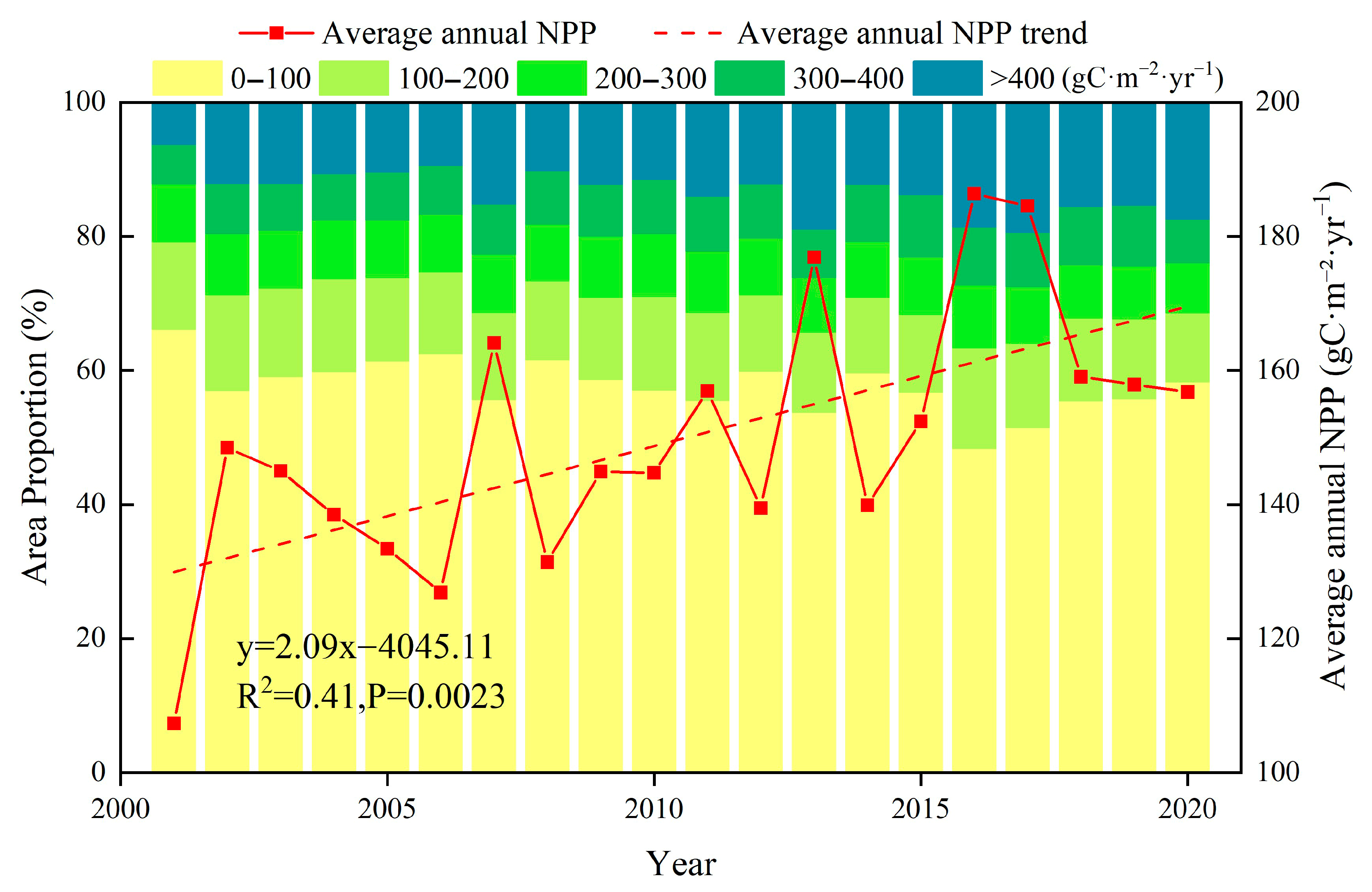
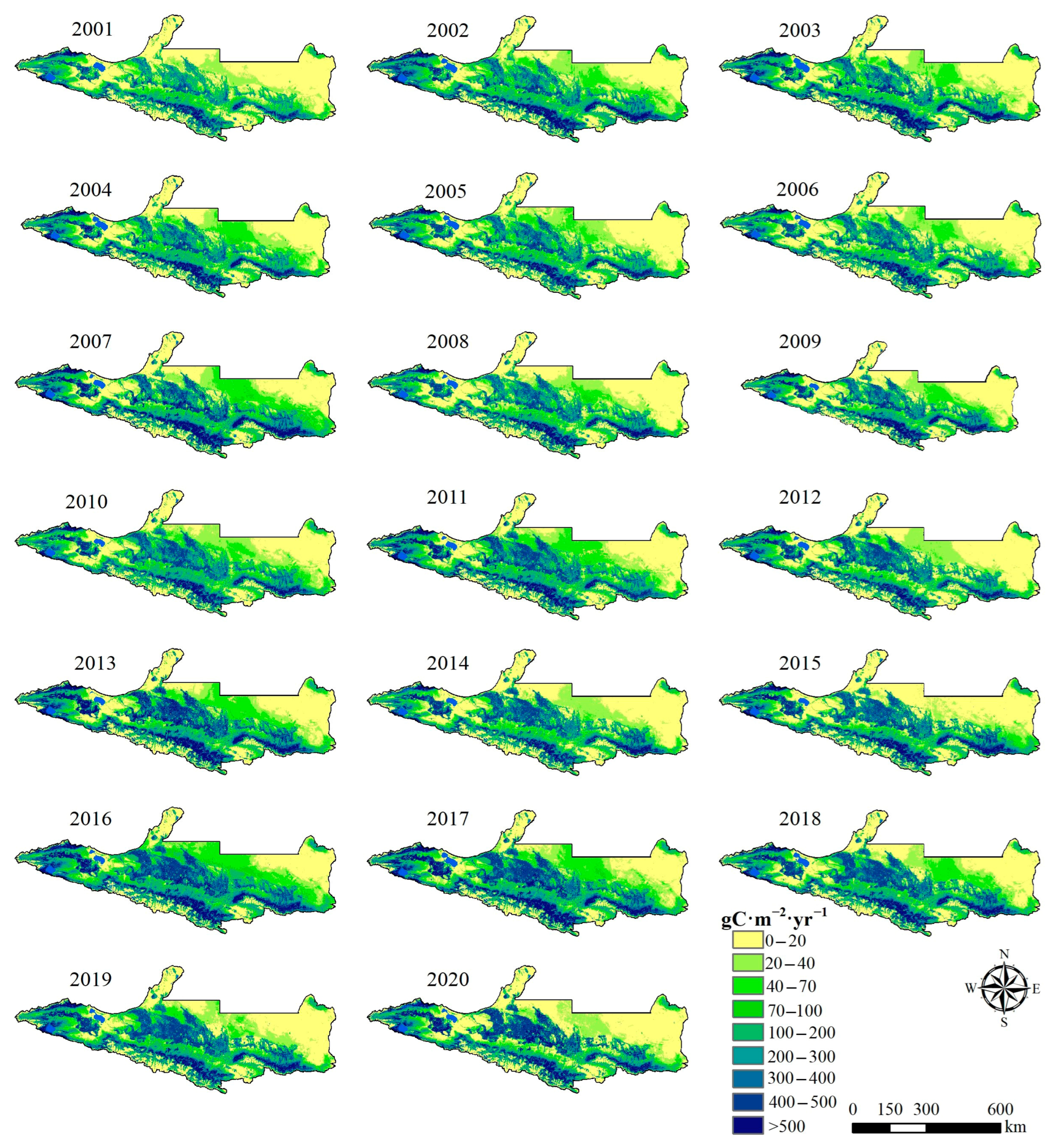


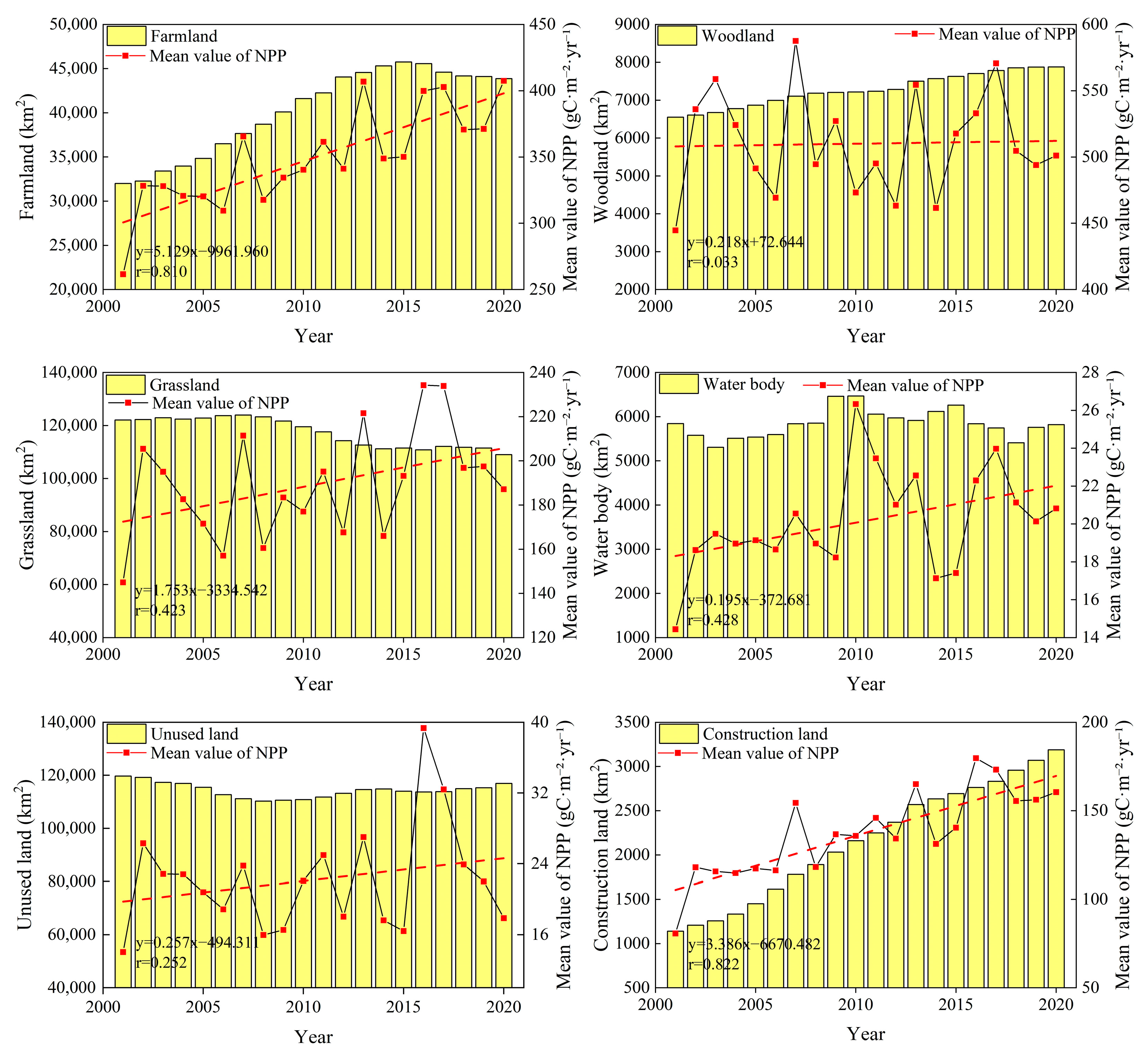
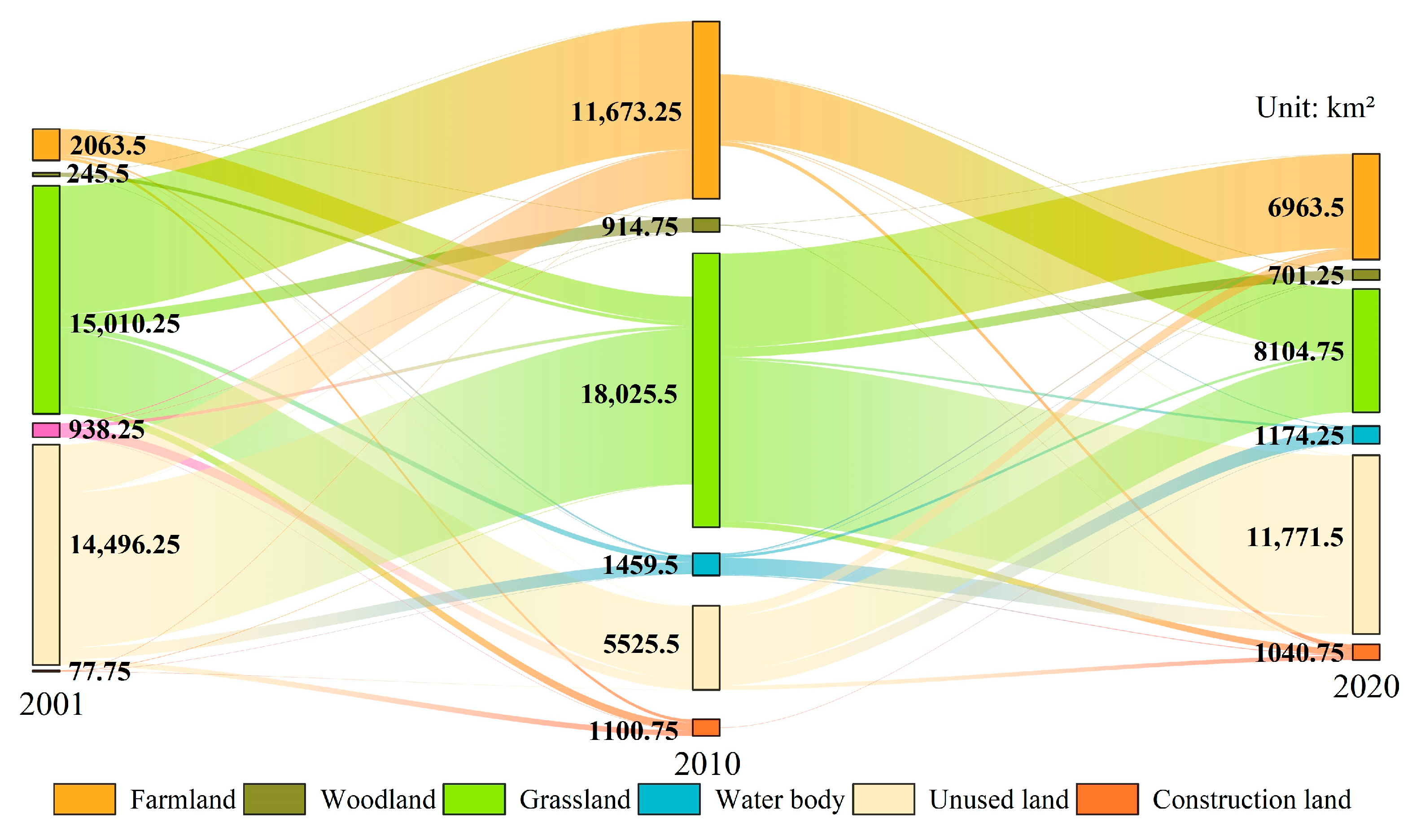

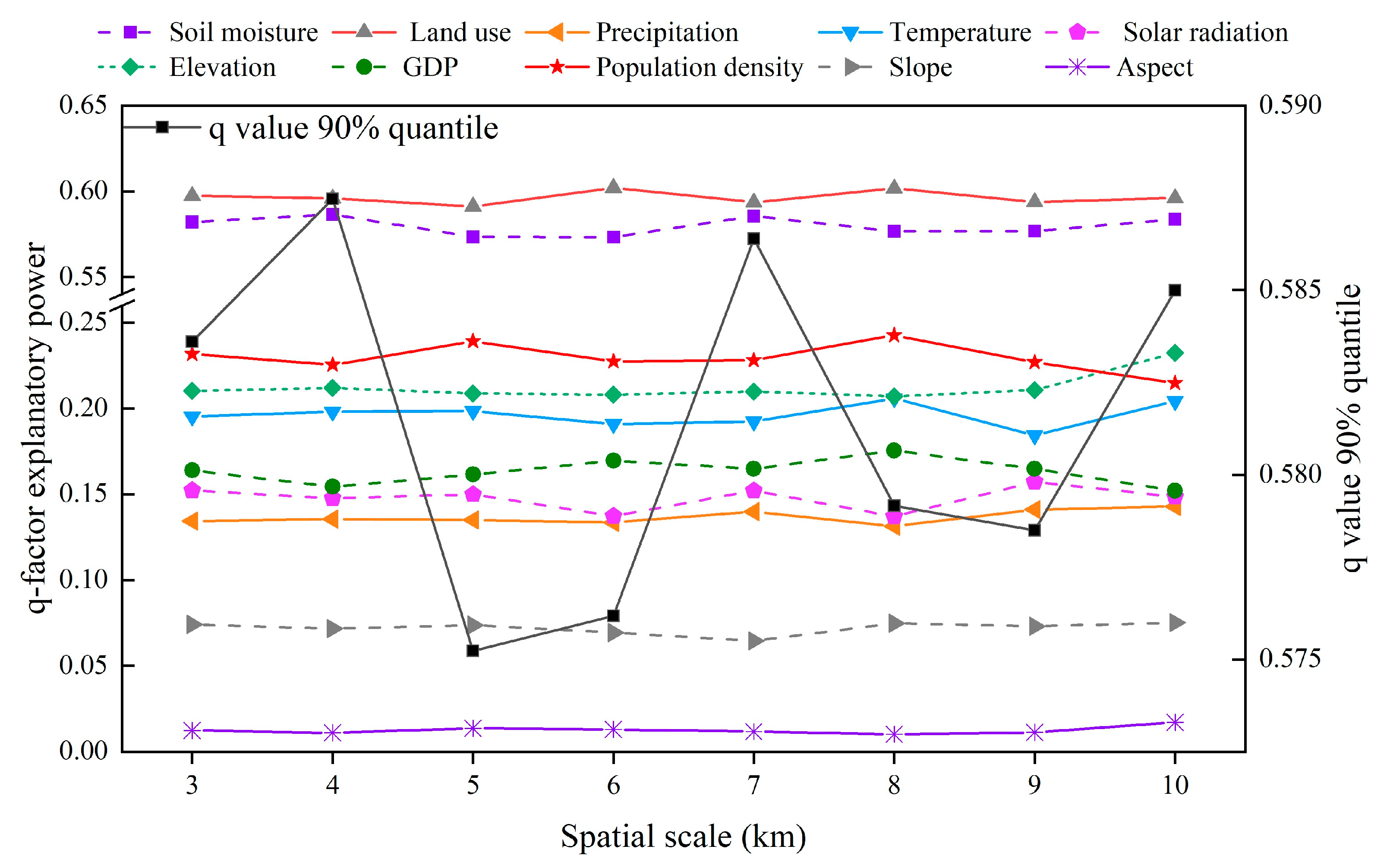

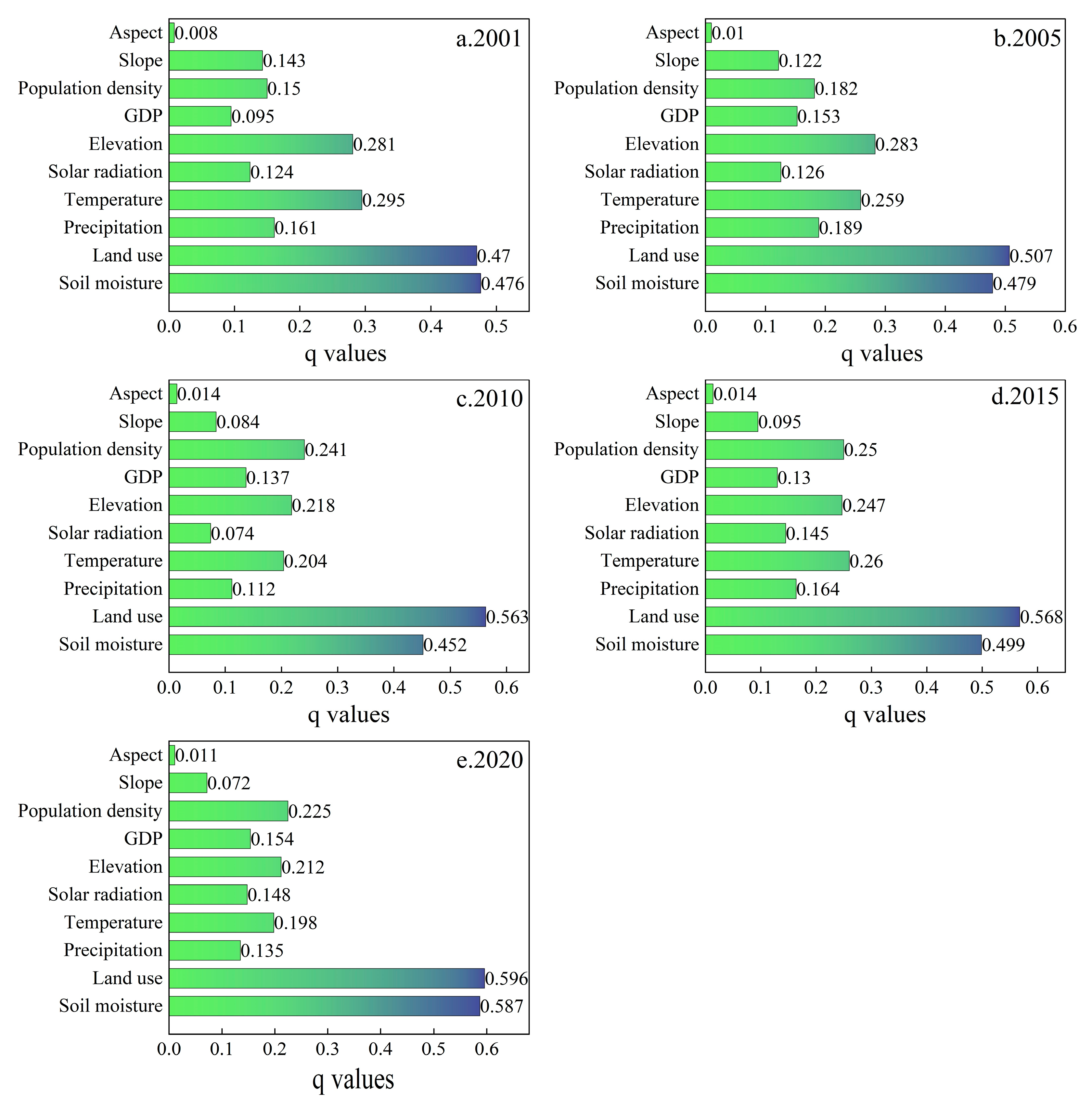
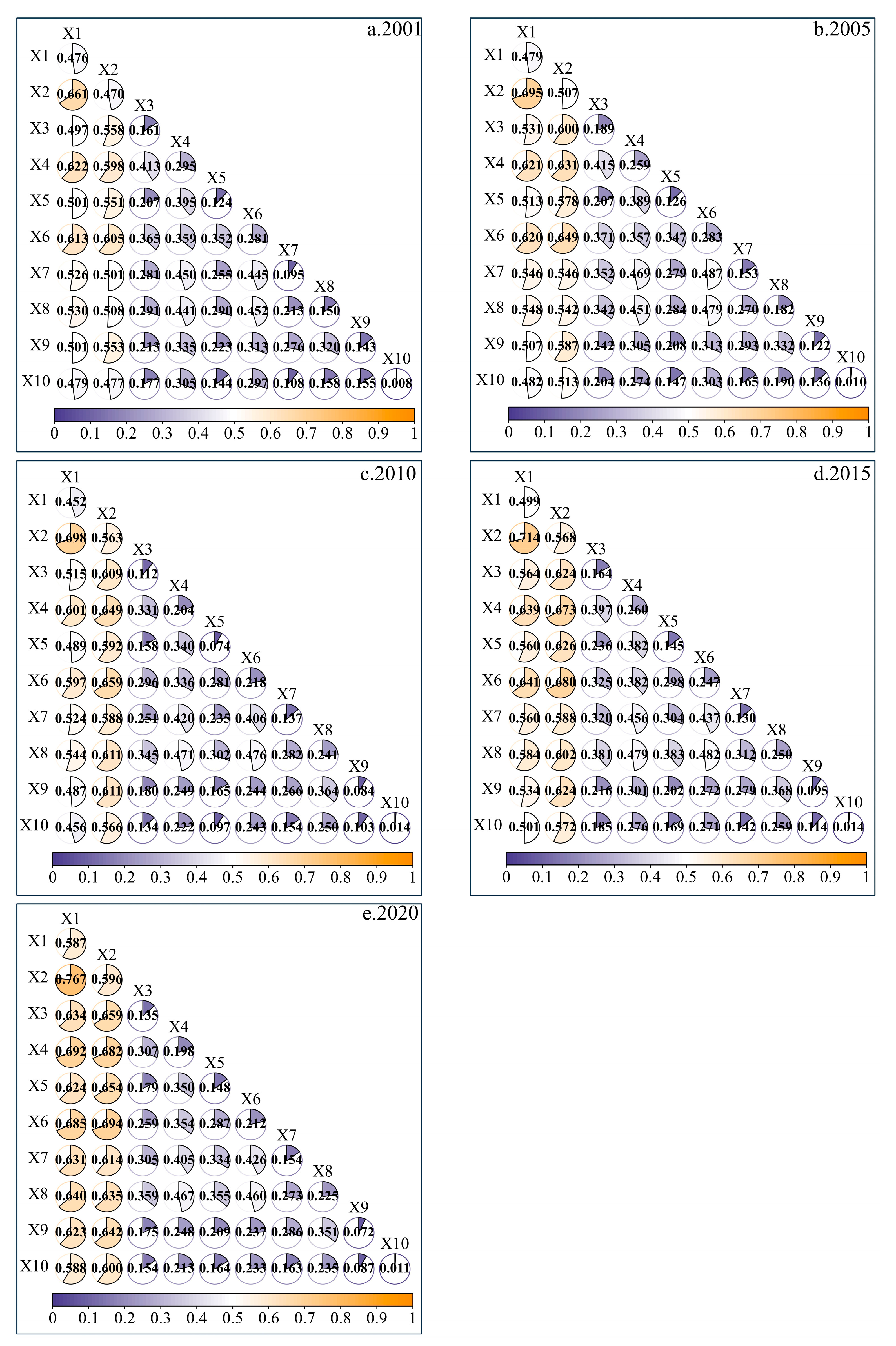

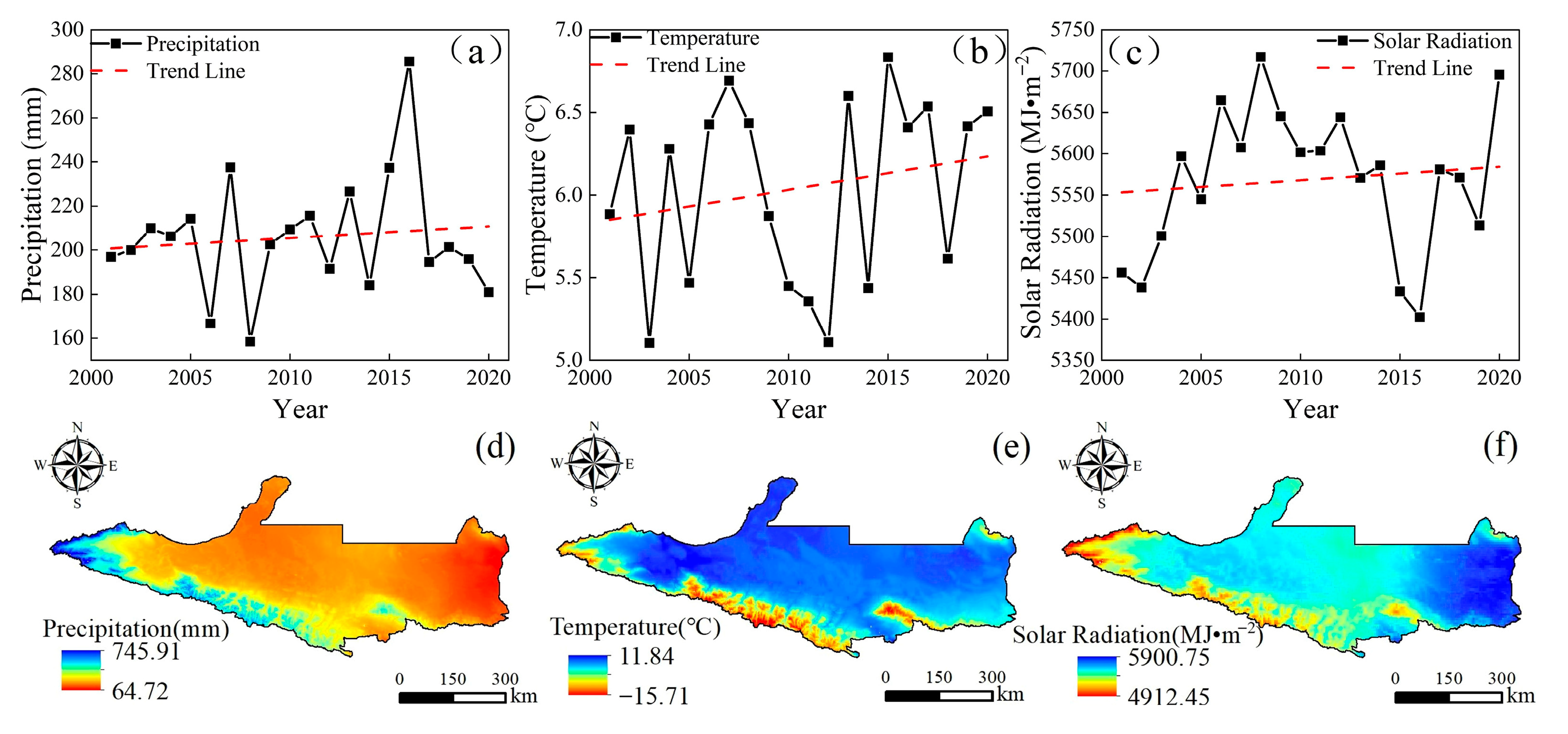
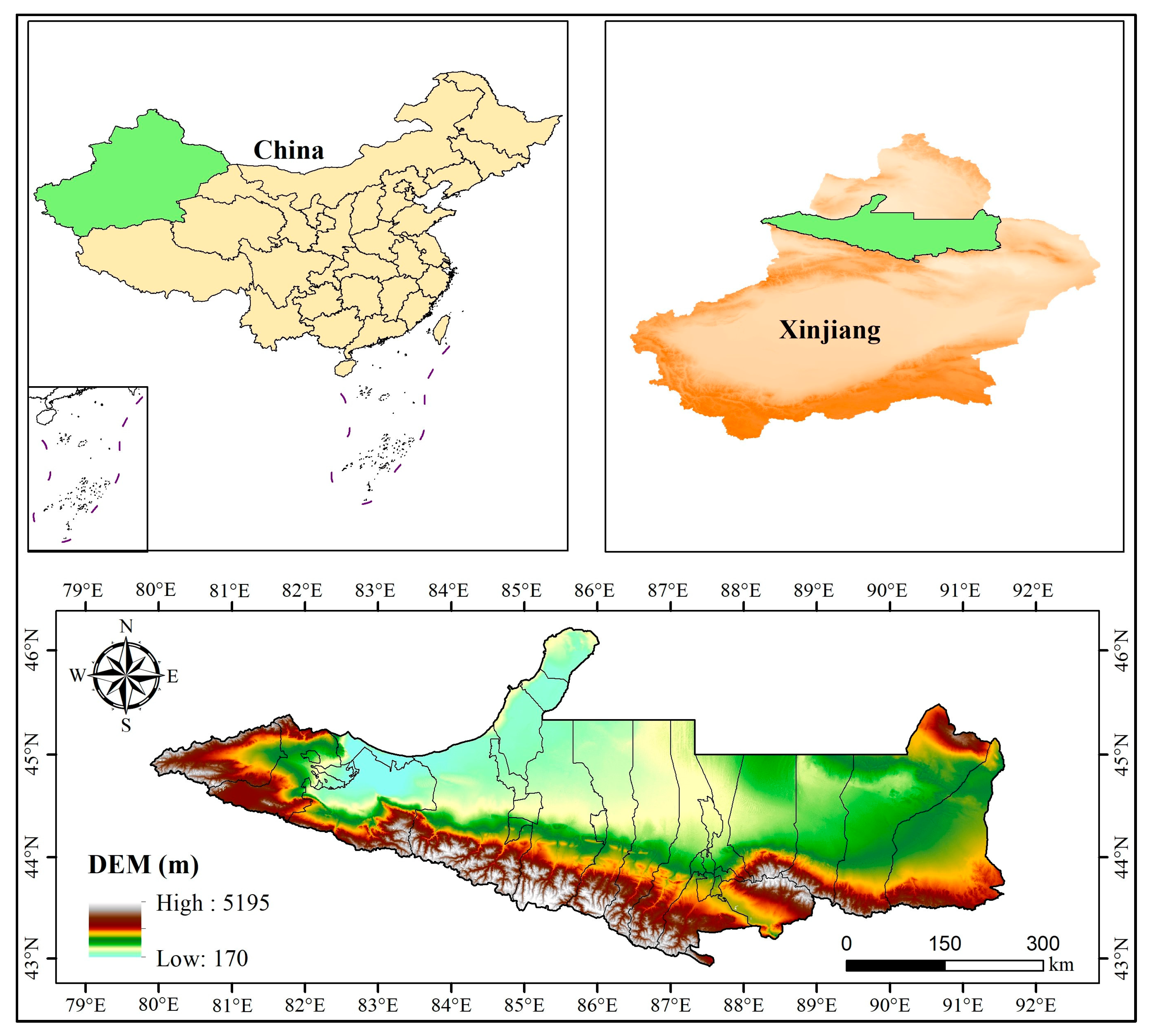

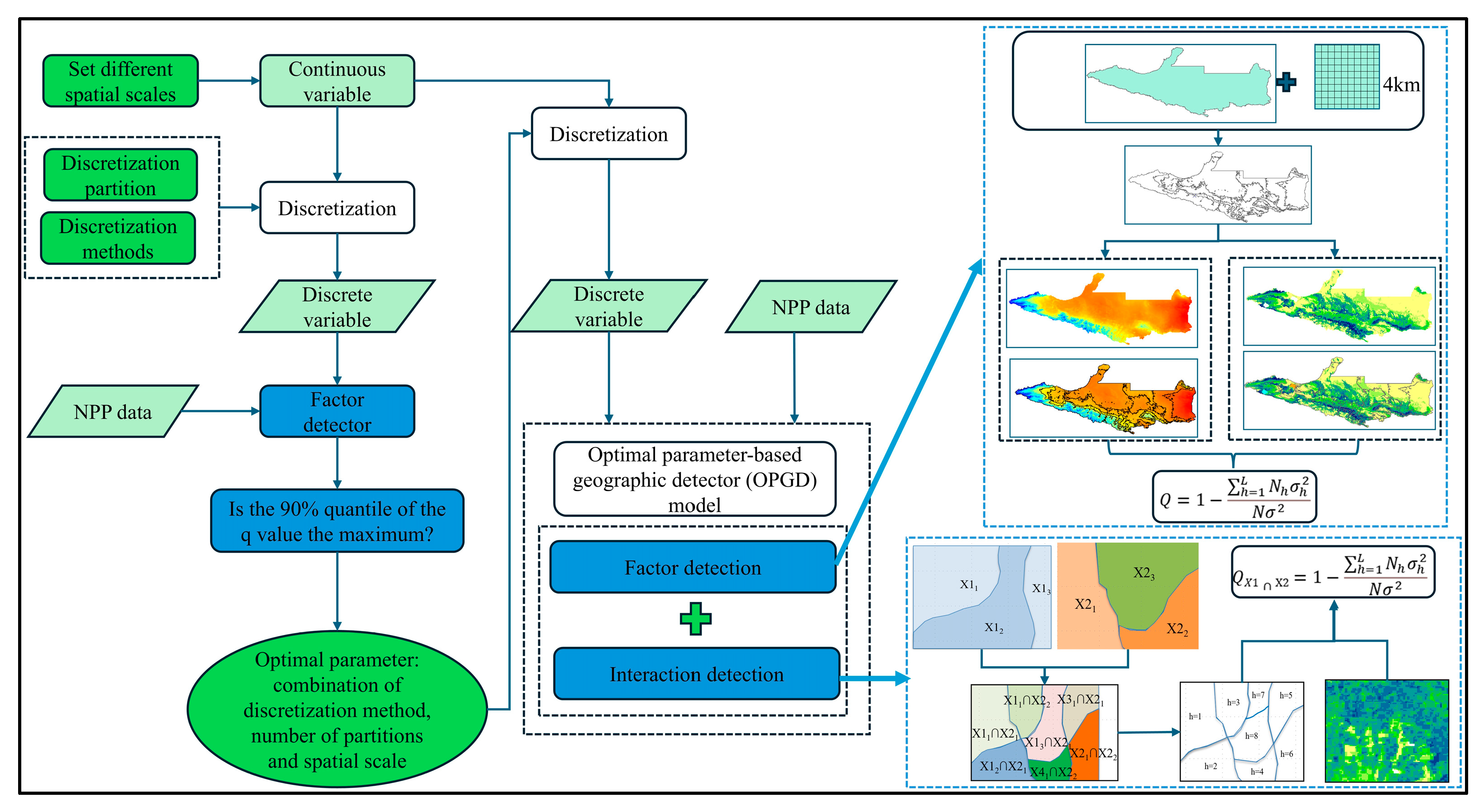
| Period | Area | Farmland | Woodland | Grassland | Reference |
|---|---|---|---|---|---|
| 2001–2020 | This study | 349.32 | 510.09 | 189.11 | — |
| 2001–2022 | Xinjiang | 404.53 | 454.40 | 199.88 | [20] |
| 2000–2020 | Xinjiang | 220–208 | 391.09–482.25 | 193.06 | [60] |
| 2001–2020 | ELB | 372.16 | 366.48 | 212.54 | [61] |
| 2001–2020 | MRB | 355.55–438.72 | 307.23–496.28 | 212.08–274.40 | [62] |
| 2001–2014 | NWCAR | 415.60 | 511.60 | 252.20 | [63] |
| Data Type | Data Source | Spatial Resolutions | Temporal Resolutions |
|---|---|---|---|
| NDVI | https://code.earthengine.google.com/ (accessed on 10 March 2025) | 500 m | Sixteen days |
| Vegetation type data | https://code.earthengine.google.com/ (accessed on 10 March 2025) | 500 m | One year |
| NPP | http://www.geodata.cn/ (accessed on 10 March 2025) | 500 m | One year |
| Temperature | https://www.tpdc.ac.cn (accessed on 18 March 2025) | 1 km | One month |
| Precipitation | https://www.tpdc.ac.cn (accessed on 18 March 2025) | 1 km | One month |
| Solar radiation | https://code.earthengine.google.com/ (accessed on 18 March 2025) | 4 km | One month |
| Land use data | http://www.geodata.cn/ (accessed on 25 March 2025) | 30 m | One year |
| Soil moisture | https://www.tpdc.ac.cn (accessed on 25 March 2025) | 1 km | One year |
| Population Data | http://www.resdc.cn (accessed on 25 March 2025) | 1 km | One year |
| GDP Data | http://www.resdc.cn (accessed on 25 March 2025) | 1 km | One year |
| DEM | https://www.resdc.cn/ (accessed on 25 March 2025) | 250 m | — |
| Slope | Z Value | Changing Trend in NPP |
|---|---|---|
| <0 | Z < −2.58 | Extremely significant reduction (ESR) |
| <0 | −2.58 < Z < −1.96 | Significant reduction (SR) |
| - | −1.96 ≤ Z ≤ 1.96 | No significant change (NSC) |
| >0 | 1.96 < Z < 2.58 | Significant increase (SI) |
| >0 | Z > 2.58 | Extremely significant increase (ESI) |
Disclaimer/Publisher’s Note: The statements, opinions and data contained in all publications are solely those of the individual author(s) and contributor(s) and not of MDPI and/or the editor(s). MDPI and/or the editor(s) disclaim responsibility for any injury to people or property resulting from any ideas, methods, instructions or products referred to in the content. |
© 2025 by the authors. Licensee MDPI, Basel, Switzerland. This article is an open access article distributed under the terms and conditions of the Creative Commons Attribution (CC BY) license (https://creativecommons.org/licenses/by/4.0/).
Share and Cite
Du, Y.; Li, X.; He, X.; Zong, Q.; Yang, G.; Zhang, F. Spatiotemporal Variation Characteristics and Driving Mechanisms of Net Primary Productivity of Vegetation on Northern Slope of Tianshan Mountains Based on CASA Model, China. Plants 2025, 14, 2499. https://doi.org/10.3390/plants14162499
Du Y, Li X, He X, Zong Q, Yang G, Zhang F. Spatiotemporal Variation Characteristics and Driving Mechanisms of Net Primary Productivity of Vegetation on Northern Slope of Tianshan Mountains Based on CASA Model, China. Plants. 2025; 14(16):2499. https://doi.org/10.3390/plants14162499
Chicago/Turabian StyleDu, Yongjun, Xiaolong Li, Xinlin He, Quanli Zong, Guang Yang, and Fuchu Zhang. 2025. "Spatiotemporal Variation Characteristics and Driving Mechanisms of Net Primary Productivity of Vegetation on Northern Slope of Tianshan Mountains Based on CASA Model, China" Plants 14, no. 16: 2499. https://doi.org/10.3390/plants14162499
APA StyleDu, Y., Li, X., He, X., Zong, Q., Yang, G., & Zhang, F. (2025). Spatiotemporal Variation Characteristics and Driving Mechanisms of Net Primary Productivity of Vegetation on Northern Slope of Tianshan Mountains Based on CASA Model, China. Plants, 14(16), 2499. https://doi.org/10.3390/plants14162499





